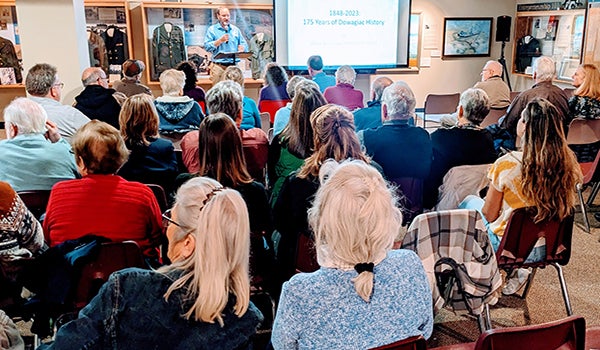Dowagiac Museum kicks off lecture series with 175 years of Dowagiac
Published 9:30 am Thursday, March 9, 2023
|
Getting your Trinity Audio player ready...
|
DOWAGIAC — At the Dowagiac Area History Museum Wednesday, visitors celebrated the city’s 175 years of existence.
Museum Director Steve Arseneau, who has spent the past 25 researching Dowagiac area history and curating the museum, kicked off the 2023 Spring Lecture Series with a lecture of his own, titled “1848-2023: 175 Years of Dowagiac History.”
Arseneau walked guests through an overview of the Grand Old City’s history, which has gone from frontier town to manufacturing city in the 20th century to a city that has adjusted to the 21st century ‘service’ economy.
The City of Dowagiac owes its existence to Nicholas Chesboro, a right of way buyer for the Michigan Central Railroad who after buying a section of Patrick Hamilton’s 80 acres of land, registered the plat with partners Mitchel Robinson and Jacob Beeson on Feb. 16, 1848. The platt was incorporated as a village in 1863 and as a city in 1877.
Arseneau said that the city’s development increased significantly from 1870 to approximately 1920, coinciding with the rise and height of Dowagiac’s furnace industry. During that time, Dowagiac became known as the Furnace City of America as it was home to four furnace companies: Round Oak, Rudy, Premier and Dowagiac Steel Furnace. The furnace boom was spearheaded by Round Oak founder and famed philanthropist P.D. Beckwith.
Immigrants came from Europe and African Americans migrated north to settle in Dowagiac and work in the factories. According to Arseneau, at one point in time approximately half of the city’s men were employed by Round Oak.
“We can really trace the city’s population growth with the growth of the factories, in particular Round Oak,” he said. “If we look at the growth of Round Oak by decades and by years and then look at the census numbers, you could probably track it on the same line.”
The 60s through the 80s saw the creation of Southwestern Michigan College in 1966 and the contraction of manufacturing in Dowagiac due to a variety of factors, including the creation of the interstate system which took Dowagiac off the road transportation’s primary highways.
“Once the Interstate Highway system came in, we were no longer on the main trunk line,” Arseneau said. “A lot of factories started moving out of town because it was hard to get the materials in and out. Even though we are still on that railroad line that was all of a sudden not the best way of moving materials in and out; trucking was and so that had an impact on why the furnace companies couldn’t survive here in Dowagiac.”
Since then, Dowagiac has worked to reinvent itself for the current economy. SMC created education opportunities for local residents and brought professors and professionals to the city.
“Area residents could have these jobs outside of local industry and administrative staff, including me in 1998. I wouldn’t be here if the college wasn’t there with the museum at that time, and in the past decade, the college’s dormitories have brought in students from across the Midwest and I see this expanding with its new rejuvenated sports program.”
Smaller scale manufacturing continues with Ameriwood, Creative Foam and Lyons Industries and the reinvention of Front Street in the 90s brought life back to downtown.
“Dowagiac, in my opinion, was about 10-15 years ahead of the curve of what most of the other Rust Belt communities that saw their jobs leave,” Arseneau said. “Dowagiac has a more thriving downtown today than many communities in southwestern Michigan, northern Indiana and Ohio because we started about 15 years before these other communities started.”other communities started.”
Fueled by the resurgence of its downtown, Arseneau believes Dowagiac’s future is bright.
“Based on how Dowagiac has evolved through the times, I think Dowagiac is going to have a good, strong future going forward.”
The Spring Lecture Series’ remaining schedule is as follows:
April 5: The Underground Railroad, The Kentucky Raid and Brownsville School No. 1, by Underground Railroad Society of Cass County
May 3: Riding the Rails: Traces of the North Berrien Interurban, by Peter Cook of the North Berrien Historical Museum
June 7: Historic Homes of Dowagiac, by Eileen Crouse of the Dowagiac Historic Home Tours 2023
Free for members, $5 for non-members







